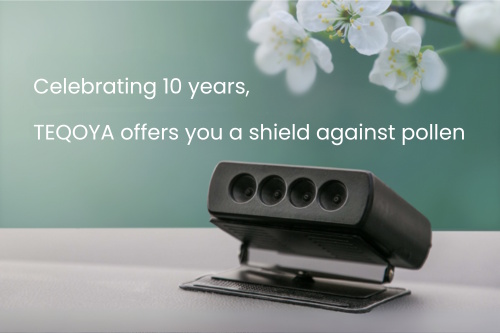Do air purifiers remove dust?
What is dust made of? And is dust dangerous to our health?
Dust is a mixture of debris and fibers: paper, textile, hair, dead skin, food debris, and more. These elements become dust when light enough to remain suspended in the air. However, due to phenomena such as static electricity and the molecular weight of its constituents, dust tends to settle on objects or agglomerate in hidden places behind furniture and other places in your home.
Apart from its unsightly appearance, dust can pose significant health risks. It can trigger respiratory discomfort, allergies (asthma in particular), and toxic or carcinogenic effects when it contains lead, beryllium, asbestos, etc. Dust particles can also cause nose damage or affect the lungs. [2] The risks to your health linked to dust are then multiple and worrying.
Also read: Do air purifiers help with dust mite allergies?
Using an air purifier can improve indoor air quality. It captures airborne particles, eliminating them and so preventing them from being inhaled.
How do air purifiers with HEPA filters remove dust?
Air filter cleaners work by drawing in air and passing it through multiple layers of filtration, effectively removing harmful particles from the air. The clean air is then released back into the room. Typically, a pre-filter first collects larger particles (hair, etc.) before an activated carbon filter prevents odors, smoke, organic compounds, and gases from passing through. Finally, a HEPA (High-Efficiency Particulate Air) filter [3] retains fine particles. This technology is the one commonly found on the market. Nevertheless, it has some disadvantages in terms of efficiency and durability.

HEPA filters have a very high-pressure drop, which increases with the amount of dirt in the filter. These pressure drops reduce the airflow and thus decrease the overall efficiency of the air purifier over time. [4] In dusty environments, filters get dirty even faster. So the more dust you have in your home, the less effective your filter air purifier will be over time!
Finally, air filter cleaners aren't the most effective at removing dust. Filter saturation makes these purifiers less efficient, less durable, and more expensive in the long run!
And how about an air purifier with a reusable filter to remove dust?
TEQOYA's new disposable filterless air purifier, TEQOYA E500, is particularly effective to remove dust. The 
At TEQOYA, you can find long-term purification solutions that are both effective and energy-efficient. That's why TEQOYA E500's filter has a large storage capacity while consuming minimal energy. TEQOYA E500 filter's unique shape, with parallel plates between which air flows, ensures that the air is not restricted even when it accumulates many particles.
Through extensive laboratory testing, our teams determined that regular cleaning of the ionizers can maintain the filter's performance, even when heavily dusted. The TEQOYA E500 filter can contain a high volume of particles and perform as well as it did when first installed.
Darlene Athimon tested TEQOYA air purifiers:
“I live on an island where sand and pollution particles can pass through several times a year, causing varying symptoms depending on one's sensitivity. These symptoms may range from mild to severe. Headaches and discomfort in the chest are examples for me. To protect myself and my family I looked for an air purifier to remove dust. I chose TEQOYA for its design, performance, and its eco-friendly guarantee. Respect for the planet is an important criteria for me!”
Are you allergic to dust? Or are you looking to get rid of sneezing and itching?
Investing in an air purifier for dust is a practical solution to improve the air quality in your home or office. TEQOYA E500's sleek design and high performance make it a reliable and long-lasting solution for air purification.
To check all of our solutions, click here 😃.
Sources
[1] OMS. "Pollution de l'air à l'intérieur des habitations et santé". https://www.who.int/fr/news-room/fact-sheets/detail/household-air-pollution-and-health
[2] Santé et sécurité: Poussières et nanoparticules - SAMANCTA (europa.eu)
[3] L'acronyme de l'anglais signifie « filtre à particules aériennes à haute efficacité ».
[4] XPAR. "La filtration de l'air". https://conseils.xpair.com/consulter_savoir_faire/filtration-air/perte-charge-filtre.htm
[5] Energie. "Entretenir le système de distribution de l'air". https://energieplus-lesite.be/gerer/ventilation5/entretenir-le-systeme-de-distribution-de-l-air/#Entretien_des_filtres
Information on air quality and news from TEQOYA
How does an air ionizer work?
#Essential
Natural environments are rich in negative ions. This is precisely the principle on which the air ionizer is based on. However, do you know how this technology manages to capture the pollution particles contained in the indoor air to purify your home?
Are air purifiers effective against viruses, especially the coronavirus COVID-19
#Virus and microorganismes #L'essentiel
In December 2019, a respiratory virus of the Coronavirus family appeared in the Wuhan region of China and has now spread to all continents.
What is eco-responsibility?
#Essential
Purifying indoor air while protecting your health and the planet is possible! Say goodbye to filters and make way for negative ions: choose an eco-responsible air purifier that will easily reduce energy and resource consumption.

